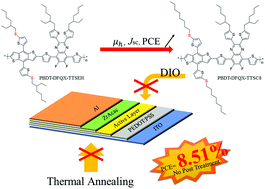High photovoltaic performance of as-cast devices based on new quinoxaline-based donor–acceptor copolymers†
Abstract
Two new donor–acceptor copolymers, namely PBDT-DFQX-TTSEH and PBDT-DFQX-TTSC8, based on difluorinated quinoxaline (Qx) acceptor units and alkylthiothienyl benzo[1,2-b:4,5-b′]dithiophene (BDT) donor units with different alkylthio side chains were designed and synthesized. The two copolymers exhibit a lower-lying HOMO energy level and closer interchain packing than their analogues with alkyl side chains attributed to the more polarizable S atom inducing stronger intermolecular interactions. Of these two polymers, PBDT-DFQX-TTSC8 with linear alkylthio side chains shows closer molecular stacking with PC71BM than PBDT-DFQX-TTSEH with branched alkylthio side chains. As a result, the polymer solar cell based on the blend of PBDT-DFQX-TTSC8 and PC71BM exhibited a higher PCE of 8.51% than that based on PBDT-DFQX-TTSEH and PC71BM, which was only 7.02%. More importantly, both copolymers show higher photovoltaic performances in as-cast devices than in those treated by additive or thermal annealing because an appropriate bulk morphology was formed during the process of spin-casting due to the strong interchain interactions of the polymers, which eliminates the need for solvent additives or thermal annealing.



 Please wait while we load your content...
Please wait while we load your content...